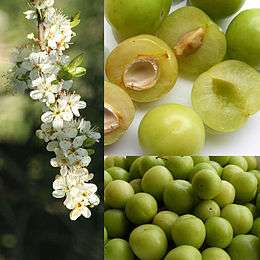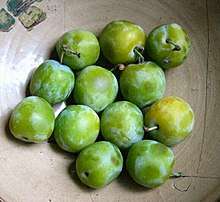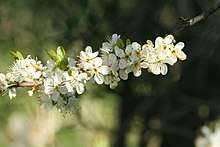Greengage
The greengages are a group of cultivars of the common European plum. The first true greengage came from a green-fruited wild plum (Persian: گوجه سبز, romanized: goje sabz) originated in Iran (Persia). Greengages are grown in temperate areas and are known for the rich, confectionery flavour. They are considered to be among the finest dessert plums.
| Greengage | |
|---|---|
 | |
| Scientific classification | |
| Kingdom: | |
| (unranked): | |
| (unranked): | |
| (unranked): | |
| Order: | |
| Family: | |
| Genus: | |
| Subgenus: | Prunus |
| Section: | Prunus |
| Species: | |
| Subspecies: | P. d. ssp. italica |
| Trinomial name | |
| Prunus domestica ssp. italica (Borkh.) Gams ex Hegi | |
| Synonyms[1] | |
|
Prunus italica Borkh. | |
The Oxford English Dictionary regards "gage" and "greengage" as synonyms.[2] However, not all gages are green, and some horticulturists make a distinction between the two words, with greengages as a variety of the gages, scientifically named Prunus domestica (subsp. italica var. claudiana.)[3][4] The gages otherwise include the large and usually purple to blackish but occasionally bright yellow round plums as well as the ancient and little-known Austrian varieties Punze (var. rotunda) and Weinkriech (var. vinaria).
Description
Greengage fruit are identified by their round-oval shape and smooth-textured, pale green flesh; they are on average smaller than round plums but larger than mirabelle plums (usually between 2 and 4 cm diameter). The skin ranges in colour from green to yellowish, with a pale blue "blush" in some cultivars; a few Reine Claudes, such as 'Graf Althanns', are reddish-purple due to crossbreeding with other plums.
History and etymology
Greengage fruit originated in Iran.[4] "Green Gages" were allegedly first imported into England from France in 1724 by Sir William Gage, 7th Baronet, from whom they get their English name,[5] though a greengage seed was found embedded in a 15th-century building in Hereford.[6] Allegedly, the labels identifying the French plum trees were lost in transit to Gage's home at Hengrave Hall, near Bury St Edmunds.[7] Soon after, greengages were cultivated in the American colonies, even being grown on the plantations of American presidents George Washington (1732–1799) and Thomas Jefferson (1743–1826). However, their cultivation in North America has declined significantly since the 18th century.
The name Reine Claude (French for "Queen Claude"), by which they are known in France, is in honour of the French queen Claude (1499–1524), Duchess of Brittany. A greengage is also called la bonne reine (French for "the good Queen") in France.[8]
Cultivation

Greengages are widely grown in particular in western Europe. The core of their range extends from France to southern England. In Germany, where they are called Reneklode or Ringlotte, numerous cultivars have been developed too. In Poland and the Czech Republic, they are known as ringle, in Hungary as ringló,[9] in Slovakia as ringloty, in Slovenia as ringlo, and in Portugal as Raínha Cláudia. They are widely grown, typically for stewing in syrup to make a compote. In Portugal, however, they make up a delicacy invented by Dominican nuns in the 16th or 17th century (when confined to their convents) in the town of Elvas, where they are boiled in a sugary syrup several times, over the course of several weeks, to then be preserved whole in syrup or dried, coated in sugar and eaten either with a local dessert, sericaia, made from eggs, sugar, milk, cinnamon and flour or eaten with rich cheeses.

At least the green cultivars breed more or less true from seed. Several similar cultivars produced from seedlings are now available; some of these include other plum cultivars in their parentage. Widely grown cultivars include:
|
|
Culture
The fruit has inspired a film, The Greengage Summer (called The Loss of Innocence in the USA) which is a 1961 British drama film set in France. It was based on the novel The Greengage Summer (1958) by Rumer Godden.
One Monty Python's Flying Circus sketch involved a deranged self-defence instructor (played by John Cleese) whose main hypothetical enemy was fresh fruit. When trying to get him to focus on more menacing foes, his exasperated students began ticking off the fruits they had already bravely battled, including 'greengages, lemons, plums, and mangoes in syrup!'
References
| Wikimedia Commons has media related to Prunus domestica subsp. italica. |
- "Prunus domestica subsp. italica". Germplasm Resources Information Network (GRIN). Agricultural Research Service (ARS), United States Department of Agriculture (USDA). Retrieved 22 July 2014.
- Shorter Oxford English dictionary, 6th ed. United Kingdom: Oxford University Press. 2007. p. 3804. ISBN 0199206872.
- Melinda Smale (Editor) Valuing Crop Biodiversity: On-farm Genetic Resources and Economic Change, p. 130, at Google Books
- Andrew F. Smith Food and Drink in American History: A "Full Course" Encyclopedia (3 Volumes, 2013), p. 681, at Google Books
- Howse, Christopher. "The gooseberry is always greener". Daily Telegraph. Retrieved 16 July 2009.
- Hensich, Bridget Ann. Fast and Feast. Penn State Press. p. 115.
- (Chambers's 20th Century Dictionary, 1903).
- "Greengage" at Bartleby.com which provides the text from Brewer, E. Cobham. Dictionary of Phrase and Fable (1898). Accessed 22 January 2007.
- http://szotar.sztaki.hu/en/hungarian-english-dictionary/search?fromlang=hun&tolang=eng&searchWord=ringl%C3%B3&langcode=en&u=0&langprefix=en%2F&searchMode=CONTENT_EXACT&viewMode=full&ignoreAccents=0&dict[]=hun-eng-sztaki-dict